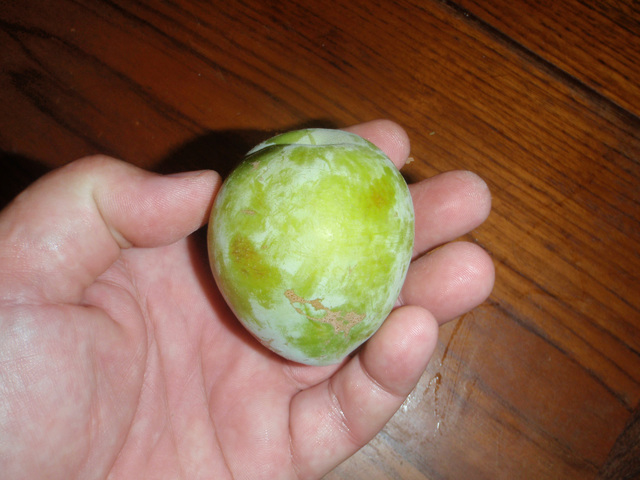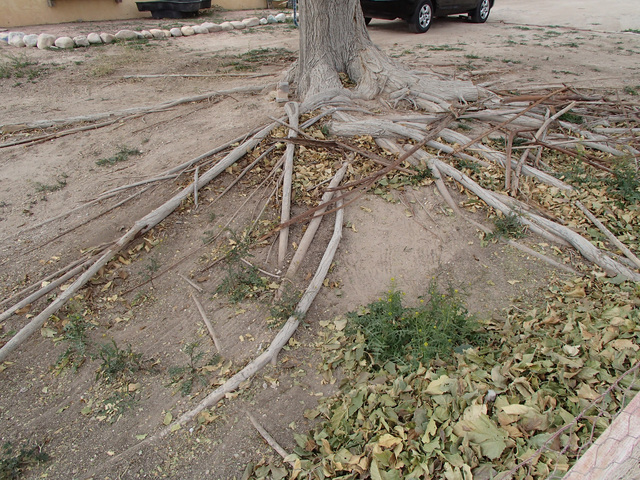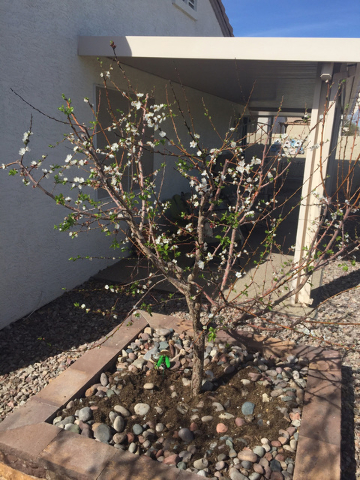Replant trees before their third or fourth year in the ground
Q: I have a young, fruiting mulberry and realized too late that it’s planted too close to a wall. When would you recommend is the best time to dig it up and transplant?
A. This fall. You usually can replant trees fairly easily up until their third or fourth year in the ground. After that, it gets a little dicey.
The best time to replant is mid-September, when temperatures cool, through mid-October. The second-best time is mid-January to mid-February. If possible, plan ahead and cut the roots with a sharp shovel within 12 to 18 inches of the trunk in about February or March. This gives the roots all spring and summer to regrow closer to the trunk before moving the tree.
Lift the tree by taking as much of the soil with the roots as possible. Pre-dig the new hole before moving the tree and amend this soil with about 50 percent compost. Move the tree with the attached soil on a large piece of cardboard or old carpet. Replant it the same orientation as it was growing previously, i.e., the north side should face north, south side should face south. Plant it at the same depth as it was previously. Paint the trunk with whitewash to protect it from sun damage.
Remove about one-third of the top of the tree to compensate for the roots that were lost in the transplant. Make sure the soil surrounding the roots of the plant is thoroughly watered in its new location. Watering thoroughly should remove the air pockets surrounding the roots. Add water to this planting hole two or three times before starting it on its new irrigation cycle. It is best to construct a 4-inch berm or moat around the tree to contain the water.
This last part is very important. Stake the tree so that the roots cannot move for one complete growing season. I don’t care about the top moving; it should. Keep the roots from moving in the soil, as they re-establish themselves in their new location. I like to use 3/8-inch rebar for a stake, about 3 feet in length, and pound it into the soil, solidly, immediately next to the trunk. Use green nursery tape and tightly secure the trunk to the piece of rebar. Remove the rebar at the end of the following summer.
Q: I planted some bare-root fruit trees early this year and am now ready to do some pruning. I have pruned fruit trees in Northern California to a V shape to collect sunlight. Should one prune differently here given that the sun is so very strong, and at times, so is the wind? A young Emerald Beauty plum is my primary concern right now.
A. Emerald Beauty plum is a great plum for our desert climate. Congratulations. It tends to grow upright, so this needs to be corrected.
You have guessed correctly. There are differences when pruning here in the desert versus pruning in Northern California. You are right, the intensity of the sunlight is one of the things we have to account for. When pruning, leave some immature growth on the interior of the tree to shade the main branches. This helps to reduce damage from sunburn.
Damage from sunburn encourages insect invasions like borers and some diseases. Painting branches exposed to direct sunlight with dilute white latex paint helps reduce damage from sunburn. Paint the upper surfaces of limbs, as well as south- and west-facing sides of the trunk.
During the first couple of years, I allow young growth from the trunk to help shade it. I remove growth from the trunk, which I don’t want, when it is older. Growth is removed when it is about pencil diameter.
As the canopy fills and shades the trunk, I remove this growth from the trunk. Yes, plants that traditionally are shaped into a V or open center include many of the plums and pluots. Remember the most productive branches are at a 45-degree angle from horizontal. Growth going straight up or straight down is less productive and removed.
Wind damage happens here particularly if they’re growing too rapidly. When trees are fertilized with too much nitrogen, they tend to grow vigorously and are subject to wind damage. Be careful with nitrogen fertilizers and do not apply too much during the growing season.
When growth is excessively long, cut it back leaving only about 18 inches remaining. Pruning of new growth can be done anytime during the year. However, pruning of older growth should be done only during the dormant season, the winter months.
Q: At one of the schools where I have a garden club there is a sunflower that has oozing coming from its stem. I think it is sweet because the wasps love it. Looks like slime flux. Any ideas what it is?
A. I am not a pathologist or entomologist, but maybe this is bacterial stem rot, which could make a yeasty smell in the sap. As the disease progresses, this sap oozes from the diseased areas. It also could be stem borer, but I think stem rot makes more sense to me from your description.
To eliminate the possibility of stem borer, cut it open at several locations along its length and see if you see a “worm” inside the stem. If you do, it is stem borer.
Smell the liquid coming from the damaged area that attracts wasps to see if it smells “yeasty.” If it does, then it is probably Erwinia (bacterial) stem rot. Anyway, this bacterial disease should have a foul smell if you get your nose right up to it. It won’t hurt you because plant diseases typically don’t hurt animals.
Q: I planted a white, fruited mulberry tree at my house close to the street. It is away from my front door or walls about 20 to 30 feet and 5 feet away from the water meter. Am I OK?
A. You should be OK if you make sure that no water is leaking from the meter or anywhere you do not want the roots to go. Keep areas where you do not want roots, dry. The roots of mulberry can be extremely invasive.
Apply irrigation water to areas away from places where you do not want roots. Roots will grow where there is water and nutrients. They don’t go “looking for water” in dry soils.
Remember, if you are focused on harvesting the fruit for yourself, prune it differently than a shade tree. If you want to feed the birds, then let it grow as a shade tree.
Q: I have a 3-year-old apricot tree in the southeast part of Las Vegas. For some reason, the leaves have dried up and appear to be dying. It gets watered daily at 3 a.m. for 2½ hours with drip irrigation at 8 gallons per hour.
A. The problem is probably the daily watering. You are giving it 20 gallons every day. It can probably handle 20 gallons every other day. Give the roots a chance to breathe by not watering daily.
If you must water the tree daily, give it smaller amounts of water. If watering too often is the problem, the bottom of the tree will move in the soil when the tree is pushed.
Ideally, the tree should be anchored firmly in the soil, and the base should not move when pushed back and forth. Keeping the soil continuously wet can promote root diseases that rot the roots. Root rot diseases favor very wet soils and invade tree roots weakened because of suffocation.
Fifteen to 20 gallons sounds about right for a vigorous 3-year-old tree. Just apply this water less often.
Another option is to improve soil drainage so the water doesn’t suffocate the roots. Improve drainage by placing vertical holes in the soil about 2 feet from the trunk.
Make the holes about 2 feet deep, and backfill them with gravel or leave them open. This technique is called vertical mulching and helps drain water away from plant roots. You can use a posthole digger for making the vertical holes.
Bob Morris is a horticulture expert living in Las Vegas and professor emeritus for the University of Nevada. Visit his blog at xtremehorticulture.blogspot.com. Send questions to Extremehort@aol.com.






























